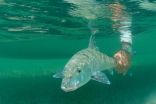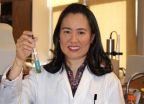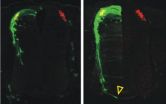(Press-News.org) MIAMI – November 22, 2010 – This October more than 60 guides and anglers in the Florida Keys poled across the flats from Biscayne Bay to the Marquesas, assisting in the annual bonefish census. This year's count, held in extremely difficult weather with lowered visibility, was down by 25-percent from an 8-year mean estimate of 316,805 bonefish to a new low of about 240,000 bonefish, according to Professor Jerry Ault, a fisheries scientist with the University of Miami's Rosenstiel School of Marine & Atmospheric Science.
"Since 2003 we have conducted an annual bonefish census throughout the Keys," said Ault. "It provides researchers, like me, and fisheries managers with an early warning system to identify trends and population changes." This year guides saw fewer bonefish in historically productive areas, a possible reflection of real population changes coupled with differences in the coastal environment. Future counts will be looking for evidence of this as an emerging population trend.
"Bonefish are a good indicator of overall ecological health. These highly mobile fish feed on small marine organisms at the base of the food chain like shrimps, crabs and baitfish; thus, the health of the bonefish population is greatly dependent on the status of the ecosystem as a whole. A change in the population is likely to signal greater issues throughout the coastal ecosystem and provide clues that we can study and address before the situation becomes critical," Ault added.
Ault suggests that if bonefish abundance did decline in 2010, it is still too early to pinpoint the reasons. However, he points out that last winter's January extended cold wave was particularly lethal to tropical gamefish species including tarpon, snook and bonefish, and to their prey. Water temperatures dipped as low as 44oF for periods of more than 3.5 days, and killed mostly small (and young) bonefish in Biscayne and Florida Bays.
The census, conducted in collaboration with local fishermen and guides, as well as the Bonefish & Tarpon Trust (BTT), and the Florida Keys Fishing Guide Associations, is important because bonefish are a major component of Florida's $5.5 billion sport-fishing industry.
Based on past results, Ault estimates each bonefish in Florida is worth about $3,500 per year to the industry or about $75,000 over its lifetime.
"We are especially grateful to the guides and anglers of the Keys who continue to work closely with us because one of the great challenges we face is the lack of long-term historical data on the Florida bonefish population," said Tom Davidson, chairman of the BTT. "The datasets we are now developing are just the beginning. We are still learning about natural variations in these dynamic systems, so we can't really be sure yet about the significance of these ups and downs. However, these types of major population fluctuations will ensure that we remain vigilant."
INFORMATION:
About the Bonefish & Tarpon Trust
Bonefish & Tarpon Trust is a non-profit, science-based conservation organization dedicated to ensuring that bonefish, tarpon, and permit populations, and the fisheries they support, remain healthy and helping to restore fisheries that have declined. BTT accomplishes this mission by funding conservation-focused research; working with local, national, and regional resource management agencies to improve regulations to protect these fisheries; and educating anglers and the public. BTT uses scientific findings to advocate for fisheries conservation and works to ensure coastal habitats used by bonefish, tarpon, and permit are protected. For more information, please visit www.tarbone.org.
About the University of Miami's Rosenstiel School
The University of Miami's mission is to educate and nurture students, to create knowledge, and to provide service to our community and beyond. Committed to excellence and proud of the diversity of our University family, we strive to develop future leaders of our nation and the world. Founded in the 1940's, the Rosenstiel School of Marine & Atmospheric Science has grown into one of the world's premier marine and atmospheric research institutions. Offering dynamic interdisciplinary academics, the Rosenstiel School is dedicated to helping communities to better understand the planet, participating in the establishment of environmental policies, and aiding in the improvement of society and quality of life. For more information, please visit www.rsmas.miami.edu.
Fall bonefish census sounds warning bell that warrants careful future monitoring
2010-11-23
ELSE PRESS RELEASES FROM THIS DATE:
Flexible wings driven by simple oscillation may be viable for efficient micro air vehicles
2010-11-23
In the future, tiny air vehicles may be able to fly through cracks in concrete to search for earthquake victims, explore a contaminated building or conduct surveillance missions for the military. But today, designing the best flying mechanism for these miniature aerial machines is still a challenging task.
Creating micro-scale air vehicles that mimic the flapping of winged insects or birds has become popular, but they typically require a complex combination of pitching and plunging motions to oscillate the flapping wings. To avoid some of the design challenges involved ...
Putting the squeeze on fat cells
2010-11-23
From fad diets to exercise programs, Americans continue to fight the battle of the bulge. Now they'll have help from recent Tel Aviv University research that has developed a new method to look at how fat cells -- which produce the fat in our bodies -- respond to mechanical loads.
This might be the key to understanding how to control the amount of fat produced by fat cells, the holy grail of weight loss researchers, says Prof. Amit Gefen of Tel Aviv University's Department of Biomedical Engineering. His research is driven by the theory that fat cells, like bone or muscle ...
Scientists clock on to how sunlight shapes daily rhythms
2010-11-23
Fresh insight into how biological clocks adjust to having less sunlight in the winter could help us better understand the impact of jet lag and shift work.
Scientists studying the daily activity cycle in plants – known as circadian rhythms – have discovered a finely tuned process that enables the plant's genes to respond to the times of dawn and dusk each day, as well as the length of daylight in between.
This system helps the plant to reset its internal clock every day in response to seasonal changes in daylight, which helps the plant control the timing of key activities ...
Bacteria help infants digest milk more effectively than adults
2010-11-23
Infants are more efficient at digesting and utilizing nutritional components of milk than adults due to a difference in the strains of bacteria that dominate their digestive tracts. Researchers from the University of California, Davis, and Utah State University report on genomic analysis of these strains in the November 2010 issue of the journal Applied and Environmental Microbiology identifying the genes that are most likely responsible for this difference.
"Human milk oligosaccharides (HMOs) are the third-largest solid component of milk. Their structural complexity ...
Hong Kong hospital reports possible airborne influenza transmission
2010-11-23
Direct contact and droplets are the primary ways influenza spreads. Under certain conditions, however, aerosol transmission is possible. In a study published in the current issue of Clinical Infectious Diseases, available online (http://www.journals.uchicago.edu/doi/abs/10.1086/656743), the authors examined such an outbreak in their own hospital in Hong Kong.
On April 4, 2008, seven inpatients in the hospital's general medical ward developed fever and respiratory symptoms. Ultimately, nine inpatients exhibited influenza-like symptoms and tested positive for influenza ...
Researchers kick-start ancient DNA
2010-11-23
BINGHAMTON, NY – Binghamton University researchers recently revived ancient bacteria trapped for thousands of years in water droplets embedded in salt crystals.
For decades, geologists have looked at these water droplets — called fluid inclusions — and wondered whether microbes could be extracted from them. Fluid inclusions have been found inside salt crystals ranging in age from thousands to hundreds of millions years old.
But there has always been a question about whether the organisms cultured from salt crystals are genuinely ancient material or whether they are ...
MU scientist develops salmonella test that makes food safer, reduce recalls
2010-11-23
VIDEO:
University of Missouri researchers have created a new test for salmonella in poultry and eggs that will produce faster and more accurate results than most currently available tests.
Click here for more information.
COLUMBIA, Mo. –Earlier this year, an outbreak of salmonella caused by infected eggs resulted in thousands of illnesses before a costly recall could be implemented. Now, University of Missouri researchers have created a new test for salmonella in poultry ...
Cutting-edge salivary diagnostics research presented at AADR 3rd Fall Focused Symposium
2010-11-23
Alexandria, Va. – The American Association for Dental Research (AADR) held its 3rd Fall Focused Symposium on November 12-13, in the Washington, DC, area. This year, the theme was the fast-moving field of Salivary Diagnostics, with a focus on Scientific & Clinical Frontiers. The symposium was sold-out, but AADR also offered a live Webinar broadcast of the oral sessions.
AADR created the Fall Focused Symposium under the objective to provide networking opportunities and exchange of ideas, and to offer small regional symposia focused on cutting-edge technology and techniques. ...
Speed heals
2010-11-23
Both the rate and direction of axon growth in the spinal cord can be controlled, according to new research by USC College's Samantha Butler and her collaborators.
The study, "The Bone Morphogenetic Protein Roof Plate Chemorepellent Regulates the Rate of Commissural Axonal Growth," by Butler; lead researcher Keith Phan and graduate students Virginia Hazen and Michele Frendo of USC College; and Zhengping Jia of the University of Toronto, was published online in the November 17 issue of the Journal of Neuroscience.
Butler, assistant professor of biological sciences, found ...
New tool detects Ebola, Marburg quickly, easily
2010-11-23
BOSTON (11-22-10) -- Boston University researchers have developed a simple diagnostic tool that can quickly identify dangerous viruses like Ebola and Marburg. The biosensor, which is the size of a quarter and can detect viruses in a blood sample, could be used in developing nations, airports and other places where natural or man-made outbreaks could erupt.
"By enabling ultra-portable and fast detection, our technology can directly impact the course of our reaction against bio-terrorism threats and dramatically improve our capability to confine viral outbreaks," said Assistant ...




